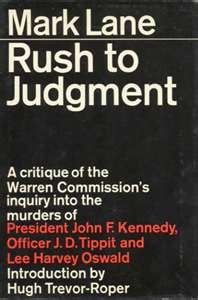 Cover of first American edition | |
| Author | Mark Lane |
|---|---|
| Subject | Assassination of John F. Kennedy |
| Publisher | Holt, Rinehart & Winston |
Publication date | August 1966 |
| Publication place | United States |
| Media type | Print (hardcover) |
| Pages | 478 pp. |
| OCLC | 4215197 |
| LC Class | E842.9 .L3 1966a |
Rush to Judgment: A Critique of the Warren Commission's Inquiry into the Murders of President John F. Kennedy, Officer J.D. Tippit and Lee Harvey Oswald is a 1966 book by American lawyer Mark Lane. It is about the assassination of United States President John F. Kennedy and takes issue with the investigatory methods and conclusions of the Warren Commission. [1] [2] The book's introduction is by Hugh Trevor-Roper, Regius Professor of History at the University of Oxford. [3]
Contents
Although it was preceded by a few self-published or small press books, Rush to Judgment was the first mass market hardcover book to confront the findings of the Warren Commission. [4] [5] It remained on The New York Times Best Seller list for six consecutive months. [6]
The title of the book was taken from Lord Chancellor Thomas Erskine's defense of James Hadfield, who had attempted to assassinate King George III in 1800. [3] According to Alex Raskin of the Los Angeles Times , "Rush to Judgment opened the floodgate for Kennedy assassination conspiracy theories". [7]
Bertrand Russell, who is thanked in the acknowledgements section of the book for being "kind enough to read the manuscript and make suggestions", [8] set up the Who Killed Kennedy? Committee in response to the book. This committee, in Russell's words, was set up "for the purpose of making known the material [Lane] has uncovered and his further findings". [9] [10] After Simon & Schuster had declined to publish the book, Russell attempted to convince them otherwise. [11] Arnold J. Toynbee is also thanked in the acknowledgements section for the same reason. [8]